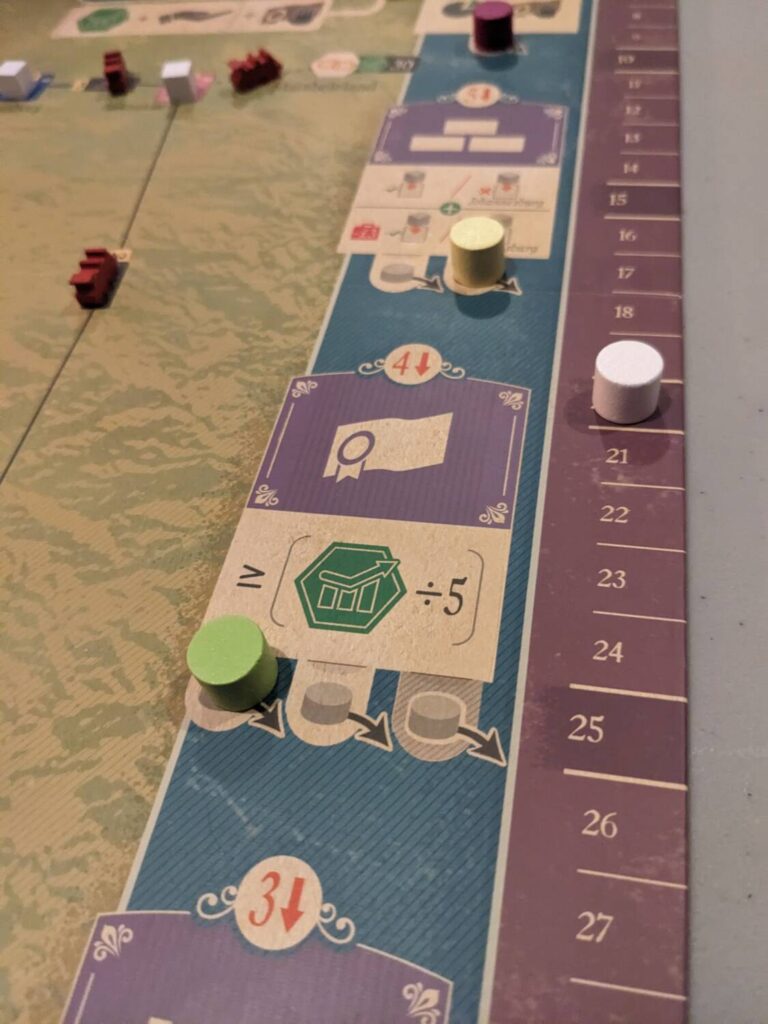Disclosure: Meeple Mountain received a free copy of this product in exchange for an honest, unbiased review. This review is not intended to be an endorsement.
If you’ve followed some of my previous content, it’s fair to say that I’ve been playing one too many train games…or you might say that I have a healthy respect for train games. I have a couple groups that are going hard on a wide spectrum of these experiences, from lighter “cube rails” games like Ride the Rails through route-building Euros like Nucluem, all the way to proper 18xx games like Railways of the Lost Atlas, 1880: China, and 18Korea, the latter of which was so ridiculous that it’s a borderline 18xx party game!
So, while I won’t profess to being a hardcore train game junkie, I’m pretty close. When Capstone Games launched a crowdfunding campaign for the fourth game in the Iron Rails series, Age of Rail: South Africa, I stayed in touch to ensure I could get a review copy when the game’s fulfillment began this fall.
Given my network—and the new game’s breezy 60-minute playtime—I knew it would be easy to get Age of Rail: South Africa to the table quickly, so I got three plays done within a three-week stretch. And because my group is familiar with two other games in the Iron Rails series, Irish Gauge and Iberian Gauge, Age of Rail: South Africa was an easy onboard.
How does it play? Honestly, Age of Rail: South Africa is more of an economic Euro-style action selection game than a traditional train game. For me, this was mostly good news.

Jo-Burg
Age of Rail: South Africa is a 3-6 player “cube rails” game, meaning that it’s a train game using small cubes to represent a corporation’s legal routes, a simplified route-building setup and a complete lack of train phases (sometimes referred to as “rusting” trains out of the game). Players are investors who must buy shares in one of the game’s six railroad companies in a scenario based on the 2003 game Veld Railroads, which was later updated and released as South African Railroads. Age of Rail: South Africa is the newest iteration of those games, with new artwork and graphic design provided by the busiest man in show business, Ian O’Toole.
Age of Rail: South Africa, like the previous versions of this design, was done by John Bohrer, the train game designer credited with more than one hundred games on his BGG profile page. But the game he is best known for is Age of Steam. Age of Steam remains popular; it feels like publisher Eagle-Gryphon Games is putting a new Age of Steam map pack on crowdfunding every year now. One of the players in my groups brings his copy of Age of Steam to game night literally every week and has gotten it to the table more than 10 times this year, a testament to both his persistence and the group’s willingness to tackle a game system so many times in a weekly game night format.
This also means we think Bohrer knows what he is doing—as if the 100 other games he’s built weren’t enough evidence—and Age of Rail: South Africa is no exception. This time around, players navigate a map of South Africa in the late 18th and early 19th centuries by taking one of four actions on their turn—build track, pay out dividends, issue shares, or develop areas of the map to make them more valuable to railroads that connect through certain locations.
If you’ve played Wabash Cannonball (another Bohrer design previously known as Chicago Express) you likely recognize what’s going on here. The auction system in Age of Rail: South Africa is also similar—players issue a share, and just taking that action is a minefield, as players sometimes put shares into the market that they have no interest in buying just to drive other players out of future near-term auctions. But auctions are the only way to inject capital into a train business, so setting shares at the right prices but also not paying too much for any single share is key.
Each action in Age of Rail: South Africa costs a certain amount of time, 3-5 units. When the time track along the right side of the board reaches a certain threshold, the game pauses and players earn dividends on each of their shares. However, players can also trigger an immediate dividend payment as an action also, meaning that the game clock can really range based on player decisions. The sixth and final dividend payment is different, taking into account a railroad company’s value based on cubes played on the map—cubes in this game are cute, miniature trains in the color of each railroad—as well as its current stock value, divided by the number of shares issued.
The richest player wins…because it’s a train game, and that’s how they all work!

The Map
The decision space in Age of Rail: South Africa is great, and it’s tied mostly to the game’s auction system. Auctions here are appropriately dangerous, I’ve now played games of Age of Rail: South Africa where I played my cards just right, and never overbid for shares that I ended up winning, and at least one game where I went too hard on shares at junctions when I definitely shouldn’t have done so, resulting in a lack of investor capital and the complete inability to bid on shares later in the game.
One of the key things to remember about Age of Rail: South Africa is the addition of the sixth railroad, the black-colored business (known as ZASM, but we’ll just stick to calling it the black railroad company here). Like the Wabash corporation in Wabash Cannonball—which is not available when play begins—the black railroad company in Age of Rail: South Africa only goes up for auction when any other railroad company connects to Johannesburg, located at the center of the map. (Black starts operations from this location.) You definitely want to have a little scratch in your pocket when this moment occurs, meaning that you really want to have $20-$30 ready to go.
The introduction of the sixth railroad created a nice tension each time I’ve played Age of Rail: South Africa. That made every other auction important too, particularly the early rounds when players were fighting over shares of the impossible decision of whether to bid on the blue and purple railroads, which are in less-than-ideal, competing areas of the southwest portion of the map. (Seriously, those corporations are comedy…both blue and purple look compromised, and purple always takes the first turn of the game. Hey, Bohrer—what gives, man?)
Speaking of the map: I think the only part of this game I don’t really love is the map layout. In each of my plays, experienced train gamers look at the situation for blue and purple and realize that they are not great places to seed initial capital. Johannesburg is undeniably sexy, so orange, yellow, and purple (sometimes blue, but not in my plays so far) are all racing to connect to “Jo-Burg” with their track building actions. Most players take the Develop action to strengthen Jo-Burg and the other major city on the map, Bloemfontein.

The first couple rounds of Age of Rail: South Africa have proven to be remarkably “samey.” The red, orange, and purple investors always build track the same way, in the same directions, towards Jo-Burg. The shares put up for auction are usually the same also. (Sadly, each company has exactly five shares available, not a variable amount by company.)
No one triggers a separate dividend payout early on, meaning that no one ever chooses to take that action. The rules of Age of Rail: South Africa force players to take different actions each turn—save for the build track action, which can be triggered multiple times consecutively by the same player—but we found that the issue shares and build track actions got most of the early-game love.
I’m not sure if that’s a good or a bad thing, but in a game this short—both of my four-player games finished in under an hour, for example, as did my three-player game—I wish that the first 15 minutes didn’t feel like they were on rails. Now, some of the game’s subtleties reveal themselves in the mid and late-game stages, so the finishes were always wild. One example occurred late in a game when a player desperately tried to get in on the action of a profitable business then blew it by overbidding on a share that wouldn’t come close to being as valuable as its final auction price.
The back half of games of Age of Rail: South Africa were fantastic, even when there was a runaway leader. But the static starting locations and available shares of each railroad, along with the scripted early game, left me wanting a bit more there.

That Bohrer Guy Knows What He’s Doing
Age of Rail: South Africa is strong, with a fantastic auction mechanic, lots of tension tied to the timing mechanics of the black railroad company, accessible rules and a playtime that is always a winner. It doesn’t take the cake for me in the Iron Rails series—I prefer Iberian Gauge at its full five-player count, as well as the sometimes-cutthroat cube placement rules and shareholder bonuses—but Age of Rail: South Africa is a game that I will happily play with my train gamer networks.
Age of Rail: South Africa’s map wasn’t the strong suit, but the game’s crowdfunding backers got access to two additional maps that shake up the game’s formula. Capstone only sent me the base game for review, so while I can’t speak to how those additional maps play, I think most cube rails games benefit from having a map that forces players to adjust the meta. Even if the base game map opened up where each of the five non-black companies began operations, or had some variability to where some of the “external connection” bonuses were based (these are the game’s equivalent to red “offboard” locations, in 18xx-speak), I would be a huge fan.
I think those extra maps give Age of Rail: South Africa life beyond the fourth or fifth play. As it is, you’re still getting a very enjoyable ride with the base game. The Iron Rails series is a proper way to introduce your friends to lightweight strategy games featuring trains, route-building, and economic/auction concepts, so give Age of Rail: South Africa a look if this is your thing!












Add Comment